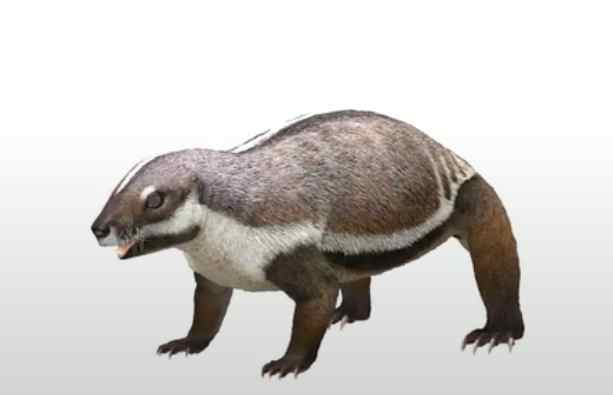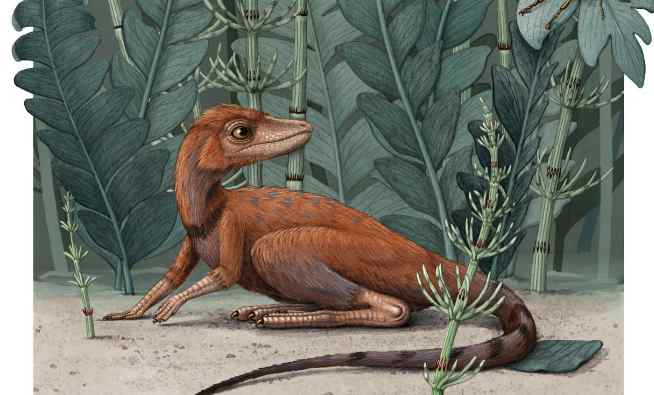
Credit: Luci Bette-Nash and Gary Staab
Paleontologists have discovered an almost complete skull of a previously unknown mammal that likely resembled a large modern-day groundhog and lived alongside dinosaurs.
The species, found on Madagascar, is shaking up theories of early mammal evolution and diversity.
Stony Brook University paleontologist David Krause led the research team, which reports its findings in today’s issue of the journal Nature.
The new fossil mammal is named Vintana sertichi.
Vintana belongs to a group of early mammals called gondwanatherians, which had been known only from a few teeth and jaw fragments.
Because of this fragmentary understanding, the mammals’ evolutionary placement hadn’t been clear. The well-preserved skull of Vintana sertichi is giving researchers their first clear insights into the life habits and relationships of gondwanatherians.
“We know next to nothing about early mammalian evolution on the southern continents,” says Krause. “This discovery underscores how little we really know. No paleontologist could have come close to predicting the odd mix of features this cranium exhibits.”
The skull measures almost five inches long, twice the size of the largest known mammal skull from the Age of Dinosaurs in the Southern Hemisphere.
At a time when the majority of mammals were shrew- or mouse-sized–mere shadows of dinosaurs–Vintana was a super heavyweight, estimated to have had a body mass of about 20 pounds, two or three times the size of an adult groundhog today.
Vintana‘s skull has an unusual shape, with deep, huge eye sockets, and long, scimitar-shaped flanges for attachment of massive chewing muscles.
“This is the first discovery of a cranial fossil from the extinct group of mammals called Gondwanatheria in the Southern Hemisphere,” says Yusheng (Chris) Liu, program director in the National Science Foundation’s (NSF) Division of Earth Sciences, which funded the research along with the National Geographic Society.
“The finding will help us better understand the early evolution of this mammal group,” says Liu.
The initial discovery came about by chance, says Krause.
Vintana means luck and refers to the good fortune its discoverer, researcher Joe Sertich, then of Stony Brook University, had in finding the fossil.
Sertich collected a 150-block rock matrix filled with fish fossils. When the block was CT-scanned at Stony Brook, the images revealed something rare inside–a nearly complete skull of a previously unknown ancient mammal.
“When we realized what was staring back at us on the computer screen, we were stunned,” says scientist Joe Groenke of Stony Brook, the first to view the CT images.
Groenke spent the next six months extracting the skull from the surrounding rock matrix, one sand grain at a time.
Krause and colleagues conducted a comprehensive analysis of the skull, much of it using micro-computed tomography and scanning electron microscopy to reveal minute aspects of its anatomy.
They compared the skull to those of hundreds of other fossil and extant mammals.
Its teeth, eye sockets, braincase, and inner ear revealed thatVintana was likely a large-eyed herbivore that was agile, with keen senses of hearing and smell.
These and other features were also used to analyze its relationships to other early mammals.
Vintana and other gondwanatherians were probably close relatives of multituberculates, the most successful mammalian contemporaries of dinosaurs on Northern Hemisphere continents.
Krause says that a major question remains for scientists: How did such an unusual creature evolve?
Madagascar was an island for more than 20 million years before the time in which the rock strata containing Vintana were deposited.
Krause theorizes that the primitive features of the skull are holdovers from a time when an ancient lineage that ultimately produced Vintana was marooned on the island.
It was this isolation, he believes, first from Africa, then Antarctica/Australia, and finally the Indian subcontinent that allowed the evolution of Vintana‘s unique and bizarre features.







